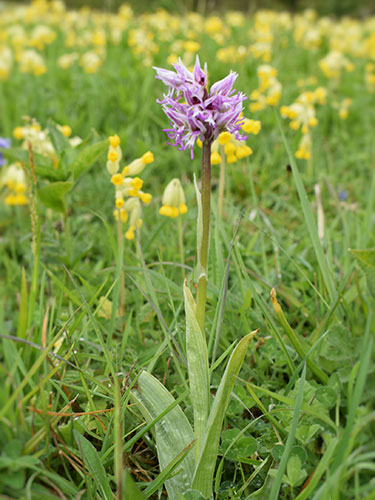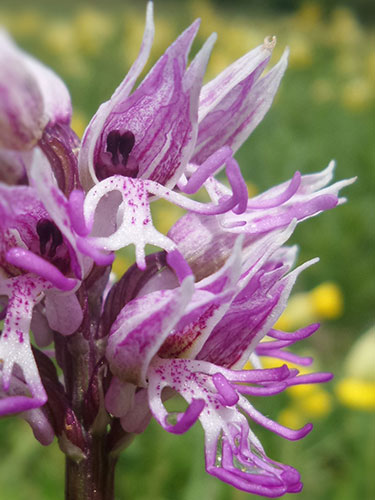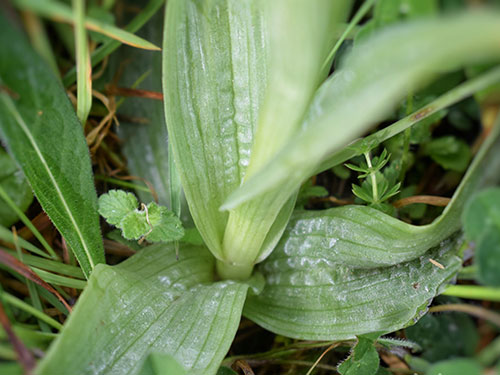


Monkey Orchid Orchis simia in situ
Photo:Natasha Clark

Orchis simia close-up of inflorescence
Photo:Natasha Clark

Orchis simia basal rosette
Photo:Natasha Clark
Monkey Orchid Orchis simia is, without doubt, no ordinary “species of the month” (‘Botanical event of the century so far!’ In the words of Nevil Hutchinson from the Sussex Botanical Recording Society) as it really doesn’t in any way conform to the usual criteria for one of our species of the month; it is only just “in season” (whatever that means in this case), it is most definitely rare, fairly tricky to identify, and it can in no way be described as under-recorded in light of the fact that to the best of our knowledge, every specimen of this species in Sussex is known and recorded in meticulous detail. There is only one.
The SxBRC was first made aware of a rumour that the remarkable discovery of a single specimen of this O. simia had been made in late May and shortly afterwards this was confirmed by an email from the discoverer, Natasha Clark who very kindly passed to us the full details which we now hold (confidentially) in our database. In order that the presence of the species is not ignored by those that need to know, we also hold a copy of the record at tetrad (2km) resolution which is available to our reporting systems.
Natasha blogged about her discovery and we have reproduced the story of her amazing discovery in full:
Of Golden Cows and Pixie-Primates ~ the Discovery of the Loneliest Orchid in the Dukedom
This weekend I went to check on a local colony of Cowslips. However, I could never have imagined that my visit to my local bunch of this country favourite, whose alternative colloquial names aptly include; 'Keys of Heaven', and 'Bunch of Keys'; after the formation of their pale-yellow flowerheads, would also be the key to an even more significant discovery...
Each Spring, I look forward to welcoming the taller cousins of the humble Primrose nodding their dainty butter-yellow heads across a sunlight meadow. As their Latin name, Primula veris, translates, these ‘first roses of Spring', are harbingers of vernal joy. They favour the calcareous grasslands of my Sussex homeland, but, as with so many of our iconic native species, their numbers are in decline. A few are scattered here and there along the ancient hedgerows and woodland edges, but visions as they once appeared, in bobbing swathes cloaking the hillside, are few and far between.
Fortunately, I know a secret vale a walk away from my peaceful West Sussex homestead where Cowslips still mass in a glorious petalled herd. I trekked over to see them, more purposefully than on previous occasions as this year, the wild plant conservation charity, Plantlife is running a Cowslip survey to assess the status of this native flora so entwined with our rural folklore and traditions.
Once I reached my destination, which, for reasons which will soon become clear has to remain undisclosed, I gazed across a wonderful collection of shin-high blooms. The Cowslips were flowering in profusion. More than I had seen before and amid the green grass of the chalk hill meadow they formed an elliptical golden island.
Speckled hither and thither between them were blue and lilac spires of Bugle, the odd Oxslip, a few rogue Bluebells, leaf rosettes of Common Spotted-orchids and several stalks of Common Twayblades; an inconspicuous species of native Orchid called Neottia ovata who bear clusters of little lime-green men clinging to the central stem. To avoid disturbing them all, I remained at the periphery and began taking photographs and recording the differences in the numbers of male and female Cowslip flowers as per the survey's area of study.
I looked across the golden haze that emanated like sunshine from the Primula herd, and saw a lone pink figure holding its head aloft. Only marginally taller than the scores of Cowslips that surrounded it stood a solitary orchid. From a distance it looked like a malformed Common Spotted-orchid, only it was much too early. Curious, I edged deeper into the island, moving forwards for a closer look.
Stepping very carefully and checking each footfall before placing my boot down, to avoid inadvertently crushing emerging Twayblades or other precious flora, I gingerly made my way towards the solitary bloom. Once above it, I immediately saw it was not a Common Spotted-orchid. In fact, it was unlike any orchid I ever laid eyes on before.
I have encountered several rare species of native Orchid in my local environs; such as Bee, Frog, Lesser Butterfly and Fly orchids, and found Bee, Pyramidal, and Common Spotted in this very location. But, being restricted to species that occur in my surrounding habitats, and seldom travelling further afield where other species can be located, I found myself staring at an orchid I’d never encountered. Nor, in hindsight, dreamt I’d ever see. I must confess, I did not know exactly what species it was, or if it was a hybrid I was unaware of. Orchid aficionados would immediately have recognised the identity of this lone beauty, but I initially didn’t. I just sensed and knew in my bones, it was very special.
It looked like an enchanted fae rattle: A cluster of hooded pixies waving their pink-sleeved arms and dancing in the air on their skinny pink-socked legs. As with all orchids, it was uniquely beautiful and quirky.
The head carried a score of cerise-pink and white flowers. The upper petals were white, veined with pink and the central petals touched at the tips to form a hood. The lower lip was also white but freckled with pink spots and it was divided into five secondary lobes which formed the curly ‘limbs’. Each flower even had a tiny ‘tail’ dangling between the lobes’ legs.
Three silvery-green basal leaves clasped the foot of its stem and a further leaf tightly cradled the upper portion. It was aesthetically very pleasing on the eye, and the aroma test rewarded my olfactory senses with the warm sweet fragrance of vanilla mixed with candied violets. Oh, what was this intriguing inflorescence?
Orchidologists would instantly identify it as Orchis simia, but the uninitiated and layman would more likely come to know it; as I did after consulting my field guides when I returned home, by its common name, the aptly described, Monkey Orchid.
Orchis simia, aka the Monkey Orchid, is one of the UK’s rarest native orchids. Classified as an Amber species, it is regarded as vulnerable and near-threatened. Named after the flower’s loose resemblance to dancing monkeys, the scientific specific epithet, ‘simia’, comes from the Latin name Carl Linnaeus gave to the primate genus.
It has only been recorded in three locations; one site in Oxfordshire, and two in Kent. It has never been recorded in Sussex. Thus, my discovery of this lone specimen is a first record for the county and a very significant find. It is, without doubt, the rarest plant I have met and potentially the most important record I will ever categorise.
Historically, there is a fascinating mystery about Monkey Orchids in Sussex. In his book, the “Flora of Sussex”, written in 1937, Anthony Hurt Wolley-Dod includes an entry for Monkey Orchids which reads “Petworth 1801”. This raised questions, as Petworth, which is only a few miles away, was deemed as not having a suitable habitat to support Orchis simia. Subsequently, research conducted to verify the account unearthed that the material used as a reference for the record was inaccurate. The drawing cited in the reference for the 1801 sighting was of Orchis simia, however, upon inspection, the inscription read;
“O. longicruris link. Mr Sokot from Petworth, Sussex, 4th June 1801”.
The inscription referred to Mr Thomas Sockett (later Reverend Sockett) who did indeed come from Petworth, but it was felt it was extremely unlikely that either Orchis simia or Orchis longicuris (the Naked Man/Italian Orchid) ever did, so the account has been disregarded as an error. That West Sussex record is therefore classed as erroneous and as it has never been recorded in East Sussex, it is believed never to have existed in the County of Sussex.
Until now.
In a small way, my find is of historical importance to the biodiversity of Sussex, and this time, there is, hopefully, no error.
Like many native Orchids, the Monkey Orchid is very particular and specialised. It flowers in late May and early June, favouring grassland, scrub and open woodland, mainly on limestone soils. It prefers south-facing slopes with full sun to mid-shade and does best on well-drained calcareous ground. It is a shortish species, growing between 15-30cm tall, but is often nearer the lower end of the height scale. It usually has 4-6 pale greenish-white basal leaves with several smaller leaves clasping the upper portion of the stem. At the top of the stem is a clustered inflorescence carrying between 15-55 flowers, which, contrary to most other orchid species open from the top downwards.
The upper petals and sepals are white, veined with deep pink and form a hood over the lip of the flower. The lip is three-lobed, white and marked with pink dots. The lip further splits into secondary lobes which are curly and protrude, therefore forming the ‘limbs of the monkey'.
As with many other Orchid species, the Monkey Orchid hybridises with other native species including the Military Orchid. Hybrids with Lady Orchids are seen in Oxfordshire at Hartslock Nature Reserve. They first appeared there in 2006 and the population is swelling considerably as their numbers multiply.
Whether in fact, there were Orchis simia in Sussex 200 years ago as the 1937 account for 1801 implied, and whether my pixie-sized floral primate is a descendant from another long-standing, but previously undetected ‘troop’ of Monkey Orchids, one will never know. But it is an intriguing thought.
Alternatively, perhaps it is a new arrival attempting to forge a new colony? One cannot be certain on either matter. What I do know, is that I have walked and explored this hidden vale for almost 20 years and never happened upon them before.
But, on the other hand, I have also discovered several other rare ancient undisturbed meadowland plants in the same location; such as the minute Adder’s Tongues fern, so the habitat is conducive and it is entirely possible that a colony once thrived here but due to the nature of the location, they have remained secret for many a time.
Its discovery certainly does beg the question, are there more Monkeys in Sussex we do not know about?
What is also certain, is that, at present, it is the only one in this location. I scoured the entire site hoping to find another, but alas not. My beautiful pixie-primate is a solitary monkey. The only one of its kind, and thus, is perhaps, the loneliest Orchid in the Dukedom.
Natasha Clark, May 2021
While we don’t expect you to find any more specimens of Orchis simia on your forays into the Sussex countryside this story really does go to show what’s still out there waiting to be recorded. The most important thing is to make sure that you get your records into iRecord but if what you are recording is particularly sensitive and you wish to “blur” the details please email bobforeman@sussexwt.org.uk with the full details.
Every month it is our aim to highlight a species that is “in-season” and, although not necessarily rare or difficult to identify, has been highlighted by our local recording groups as being somewhat under-recorded and for which new records would therefore be welcomed.
If you or your recording group are aware of species such as this then please contact Bob Foreman.